| Article ID | Journal | Published Year | Pages | File Type |
|---|---|---|---|---|
| 1301289 | Coordination Chemistry Reviews | 2007 | 40 Pages |
The present review summarizes the syntheses, structures, physicochemical properties and reactivity of complexes containing η1-, μ-, μ3- and μ4-vinylidene ligands. Consideration of mononuclear vinylidene complexes is limited to cymantrene derivatives, one of which, viz. Cp(CO)2MnCCHPh (1), has served as the precursor for syntheses of many organometallic and some organic compounds. The reactions between phosphites P(OR)3 and complex 1 afford styrylphosphonates PhCHCHP(O)(OR)2. All the transformations of complex 1 occur under very mild conditions. Special attention is paid to heterometallic complexes, containing Mn, Fe and the platinum Group metals with bridging vinylidene ligands. The MnCCHR system is used as a “building block” for a series of dimetal μ-vinylidene complexes including MnM bonds (M = Mo, W, Mn, Re, Fe, Rh, Pd, Pt, Cu) and trimetallic MnFePt μ3-vinylidene clusters. Transmetalation reactions of the MnPd and MnPt complexes have given a series of μ4-vinylidene PdFe3 and PtFe3 clusters. Transfer of vinylidene from the Mn atom to another metal atom (Re), to the dinuclear (FePt) and cluster (Os3, PdFe3, PtFe3) systems has been shown. A systematic study of a dependence of structural and spectroscopic parameters of mono-, di-, tri- and tetra-nuclear complexes on the vinylidene coordination mode has been carried out.
